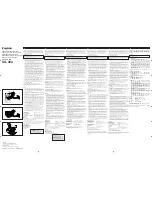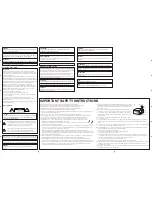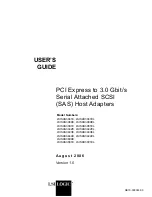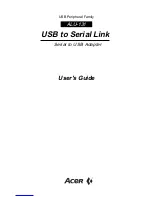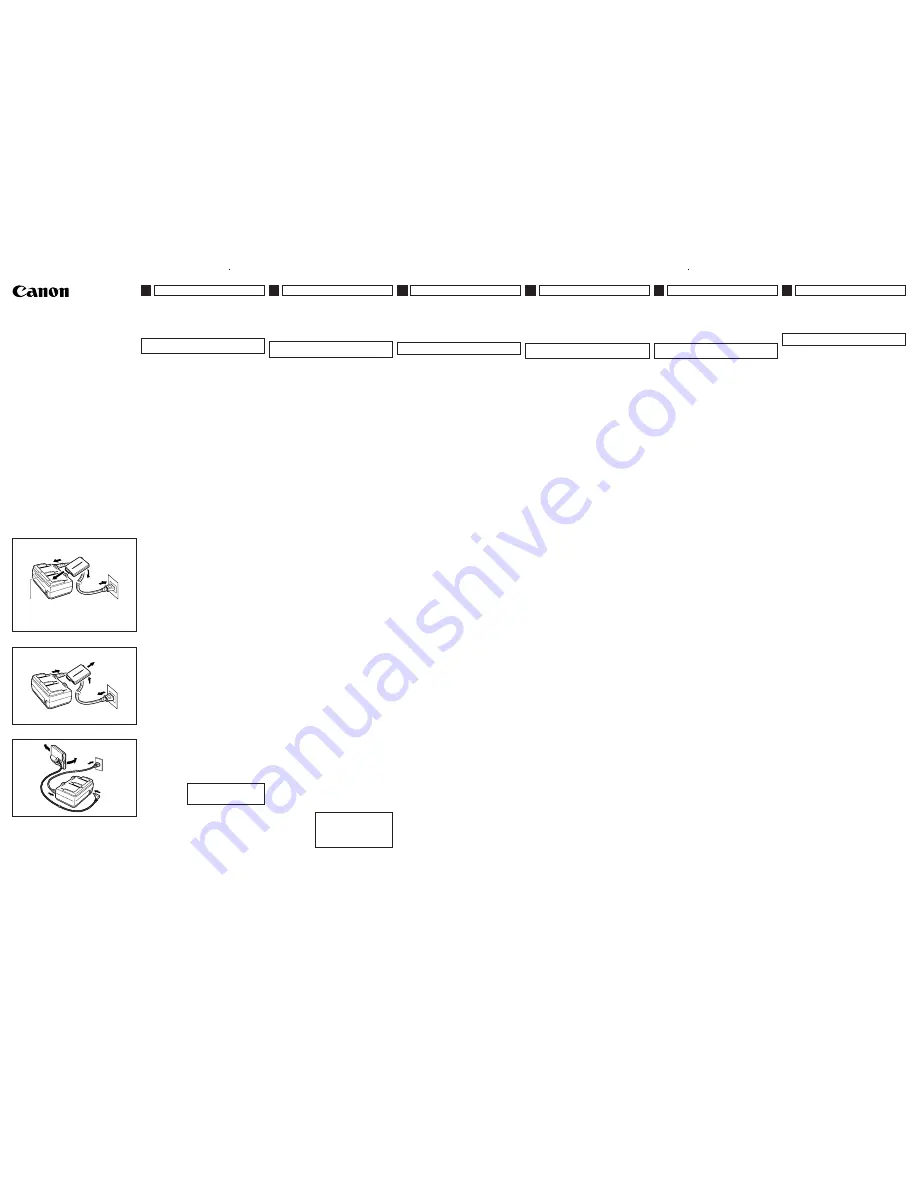
E
INSTRUCTIONS
English
I
ISTRUZIONI
Italiano
C
使用说明书
中 文
Thank you for purchasing this adapter. It will charge two Canon
lithium ion battery packs, and can be connected to a DC coupler to
power your camcorder from a household power socket. Please
check your instruction manual to make sure that your camcorder is
compatible with this adapter.
To charge battery packs:
Make sure the camcorder’s DC coupler is not connected to the
adapter. The battery pack(s) will not charge if the DC
coupler is connected to the adapter.
1. Connect the power cable to the adapter (Fig. 1-
1
) and plug the
power cable into a household power socket (Fig. 1-
2
).
2. Attach one or two battery packs to the adapter (Fig. 1-
3
).
• Insert the battery’s terminals into the adapter and press the
other end until it clicks into place.
• One of the two charge indicators starts flashing to show the
progress of charging. Single flashes mean that the battery is
less than 50% charged. Double flashes mean that it is 50–75%
charged. Triple flashes mean that it is more than 75% charged.
(All charging levels are approximates.) The indicator glows
steadily when the battery pack is fully charged.
• If you attach two battery packs, they are charged one following
the other (i.e. sequentially).
In this case, a red charge indicator shows the progress of
charging for the battery pack that you attached first. (Or for the
battery pack attached to the side labelled A, if you attached
both before plugging the adapter into a household power
socket.) When the indicator starts to glow steadily (the first bat-
tery is fully charged), the second charge indicator shows the
progress of charging for the other battery pack. When both bat-
tery packs are fully charged, both indicators glow steadily.
• To check the remaining power of a battery pack, attach a single
battery pack to the adapter, and check the charge indicator.
3. Remove the battery pack. Unplug the adapter and disconnect the
power cable from the adapter (Fig. 2).
To power your camcorder from a household power socket:
1. Connect the DC coupler to the camcorder (Fig. 3-
1
). Refer to
your camcorder’s instruction manual for details.
2. Connect the power cable to the adapter (Fig. 3-
2
) and plug the
power cable into a household power socket (Fig. 3-
3
).
3. Connect the DC coupler to the adapter’s DC terminal (Fig. 3-
4
).
To disconnect the adapter:
1. Turn the camcorder off and detach the DC coupler.
2. Disconnect the DC coupler from the adapter.
3. Unplug the adapter and disconnect the power cable from the
adapter.
Notes:
• If the adapter does not seem to be working, this may be
because its safety circuit has been activated. Unplug the adapter,
wait a few minutes, and plug it in again. (If it still does not work,
it has malfunctioned and should be returned to a Canon Ser-
vice Center for repair.)
• If the adapter is used next to a TV, it may cause the TV to emit
noise–move the adapter away from the TV or the antenna/aerial
cable.
• Never unplug the adapter during use, and never disconnect the
DC coupler from the adapter when the camcorder is being
powered from a household power socket.
• When powering your camcorder from a household power socket
you do not need to remove the battery packs from the adapter,
but charging will not take place until you remove the DC coupler
from the adapter (charging then begins from the side labelled
A).
• Be sure to unplug the adapter when you have finished using it.
• The adapter can be used with a power supply between 100 and
240 V AC. Contact your Canon dealer for information about plug
adapters for overseas use.
• To prevent equipment breakdowns and excessive heating, do
not connect this adapter to voltage converters used by travel-
ers, or special power sources such as on aircraft, ships or DC
to AC inverters, etc.
• Use only specified products with this adapter.
• You can only use the BP-400 Series Battery Packs with this
adapter.
• Do not disassemble the adapter, do not get it wet, and do not
expose it to shock or vibration, or to direct sunlight. Avoid
exposure to high temperatures, such as in a closed car in hot
weather, and do not leave it near heat–radiating equipment,
such as a stove or heater.
Specifications:
Power supply:
100–240 V AC, 50/60 Hz
Power consumption:
40 W
Rated output:
Adapter mode: 7.2 V, 2.0 A DC
Charger mode: 8.4 V, 1.0/2.5A DC
Operating temperature range:
0
°
– 40
°
C (32
°
– 104
°
F)
Dimensions:
75
×
120
×
53 mm (3
×
4
3
/
4
×
2
1
/
8
in)
Weight:
250 g (8
7
/
8
oz) (without power cable)
Weight and dimensions are approximate. Errors and omissions ex-
cepted. Subject to change without notice.
Canon is a trademark of Canon Inc.
When the replacement of power supply is required, please return it
to the responsible nearest Canon Service Center, and please re-
place it with the same type number CA-400 or equivalent.
Date of Purchase
Dealer Purchased From
Dealer Address
Dealer Phone No.
Model No. CA-400
Serial No.
Compact Power Adapter CA-400
Adaptateur secteur compact CA-400
Netzadapter/Ladegerät CA-400
Alimentador de corriente compacto CA-400
Adattatore compatto CA-400
轻便型功率适配器
CA-400
CANON INC.
CANON U.S.A., INC. NEW JERSEY OFFICE
100 Jamesburg Road, Jamesburg, NJ 08831 USA
CANON EUROPA N.V.
P.O. Box 2262, 1180 EG Amstelveen, the Netherlands
PUB. DIM-357 ic
©CANON INC. 2002
PRINTED IN JAPAN
0600A/AB0.6
DY8-9120-252-000
IMPRIME AU JAPON
De
ANLEITUNGEN
Deutsch
Wir danken Ihnen für das Vertrauen, das Sie Canon mit dem Kauf
dieses Geräts erwiesen haben. Das CA-400 dient zum Aufladen
von zwei Lithiumionen-Akkus und kann darüber hinaus einen
Camcorder mit Netzstrom betreiben. Vergewissern Sie sich bitte
anhand der Bedienungsanleitung, dass Ihr Camcorder mit diesem
Gerät kompatibel ist.
Zum Laden von Akkus:
Stellen Sie sicher, dass der Gleichstromkoppler nicht
angeschlossen ist. Andernfalls ist kein Aufladen möglich.
1. Schließen Sie das Netzkabel erst an den Netzadapter (Abb. 1-
1
)
und dann an eine Netzsteckdose (Abb. 1-
2
) an.
2. Bringen Sie ein oder zwei Akkus am Netzadapter an (Abb. 1-
3
).
• Setzen Sie die Akkukontakte an den Netzadapter an und
drücken den Akku bis zum Einrasten ein.
• Die blinkende Ladekontrolllampe informiert über den Ablauf des
Ladevorgangs. Einfaches Blinken bedeutet, dass der Akku
weniger als 50% geladen ist. Doppelblinken zeigt eine Ladung
von 50 bis 75% an. Bei dreifachem Blinken ist der Akku mehr
als 75% geladen. (Alle Ladepegel sind Annäherungswerte.) Bei
voll geladenem Akku leuchtet die Kontrolllampe kontinuierlich.
• Wenn Sie zwei Akkus ansetzen, werden diese nacheinander
geladen.
In einem solchen Fall zeigt eine rote Ladeanzeige an, dass der
Ladevorgang für den zuerst angesetzen Akku ausgeführt wird
(oder für den Akku, der an der Seite mit der Markierung A
angebracht ist, wenn beide Akkus vor dem Anschließen das
Netzadapters an eine Netzsteckdose angesetzt wurden).
Sobald diese Kontrolllampe kontinuierlich leuchtet (Akku voll
geladen), informiert das Blinken der zweiten Kontrolllampe über
den Zustand des Ladevorgangs für den zweiten Akku. Wenn
beide Akkus vollständig geladen sind, leuchten beide
Kontrolllampen kontinuierlich.
• Um die Reststärke eines Akkus zu bestimmen, setzen Sie
diesen in den Netzadapter und prüfen Sie die Ladeanzeige.
3. Entfernen Sie den Akku, und trennen Sie den Netzadapter vom
Netz. (Abb. 2).
Netzbetrieb:
1. Schließen Sie den Gleichstromkoppler an den Camcorder an
(Abb. 3-
1
). Einzelheiten siehe die Bedienungsanleitung des
Camcorders.
2. Schließen Sie das Netzkabel an den Netzadapter (Abb. 3-
2
) an
und dann an eine Netzsteckdose (Abb. 3-
3
).
3. Schließen Sie den Gleichstromkoppler an die Gleichstrombuchse
des Netzadapters an (Abb. 3-
4
).
Abtrennen des Netzadapters:
1. Den Camcorder ausschalten und den Gleichstromkoppler
abtrennen.
2. Den Gleichstromkoppler vom Netzadapter trennen.
3. Den Netzadapter vom Netz trennen.
Hinweise:
• Wenn der Netzadapter nicht funktioniert, ist u.U. seine
Schutzschaltung aktiviert. Trennen Sie den Netzadapter vom
Netz, warten Sie einige Minuten, und schließen Sie ihn dann
wieder an. (Sollte dies keine Abhilfe schaffen, liegt eine Störung
vor, die durch einen Canon Service-Partner behoben werden
muss.)
• Beim Einsatz des Netzadapters in der Nähe eines Fernsehers
können Empfangsstörungen auftreten. Vergrößern Sie in
diesem Fall die Entfernung zum Fernseher bzw. zum
Antennenkabel.
• Trennen Sie niemals den Netzadapter während des Betriebs
vom Netz, und trennen Sie niemals den Gleichstromkoppler
vom Netzadapter, während der Camcorder über den
Netzadapter betrieben wird.
• Bei Netzbetrieb des Camcorders braucht der Akkus nicht aus
dem Netzadapter entfernt zu werden. Es erfolgt jedoch kein
Ladevorgang, solange der Gleichstromkoppler angeschlossen
bleibt.
• Vergessen Sie nach Gebrauch des Netzadapters nicht, den
Netzadapter vom Netz zu trennen.
• Der Netzadapter ist für Eingangsspannungen zwischen 100
und 240 V ausgelegt. Hinsichtlich Steckerkonfigurationen für
den Betrieb im Ausland wenden Sie sich an Ihren Canon
Fachhändler.
• Um Erhitzen und mögliche Funktionsstörungen zu vermeiden,
darf der Netzadapter nicht an Spannungswandler (wie z.B. auf
Reisen) oder an spezielle Stromquellen (wie z.B. im Flugzeug,
auf einem Schiff usw.) oder DC/AC-Wechselrichter und
dergleichen angeschlossen werden.
• Verwenden Sie mit diesem Netzadapter ausschließlich die
empfohlenen Produkte.
• Sie können nur Akkus der Serie Canon BP-400 mit diesem
Netzadapter laden.
• Zerlegen Sie den Netzadapter nicht, und schützen Sie ihn vor
Nässe, Stößen und Erschütterungen sowie direkter
Sonneneinstrahlung. Setzen Sie ihn keinen hohen
Temperaturen aus, wie beispielsweise in einem in der Sonne
geparkten Fahrzeug, und halten Sie ihn von Heizkörpern und
anderen Wärme erzeugenden Geräten fern.
Technische Daten:
Stromversorgung:
100-240 V WS, 50/60 Hz
Leistungsaufnahme:
40 W
Ausgangsspannung:
7,2 V GS, 2,0 A (Netzbetrieb)
8,4 V GS, 1,0/2,5A (Ladebetrieb)
Betriebstemperatur:
0˚C bis 40˚C
Abmessungen:
75
×
120
×
53 mm
Gewicht:
250 g (ohne Netzkabel)
Gewicht und Abmessungen sind annähernde Werte.
Irrtümer und Auslassungen vorbehalten.
Ausschließlich die empfohlenen Produkte verwenden.
F
INSTRUCTIONS
Français
Nous vous remercions d'avoir choisi cet adapteur. Il vous permet
de charger deux batteries lithium-ion Canon et peut être raccordé à
un coupleur DC pour alimenter votre camescope à partir d’une
prise secteur. Veuillez vous reporter au mode d'emploi de votre
camescope pour s'assurer que celui–ci est compatible avec cet
adapteur.
Pour charger les batteries:
Assurez-vous que le coupleur DC du camescope n’est pas
raccordé à l’adaptateur. La ou les batteries ne se chargeront pas
si le coupleur DC est raccordé à l’adaptateur.
1. Raccordez le cordon d’alimentation à l’adaptateur (Fig. 1-
1
) et
branchez le cordon d’alimentation sur une prise secteur (Fig. 1-
2
).
2. Rattachez une ou deux batteries à l’adaptateur (Fig. 1-
3
).
• Insérez les bornes de batterie dans l’adaptateur et appuyez sur
l’autre extrémité jusqu’à ce qu’elle s’encliquette.
• Un des deux indicateurs de charge commence à clignoter pour
indiquer que le processus de charge est en cours. Des
clignotements simples signifient que la batterie est chargée à
moins de 50%. Des clignotements doubles indiquent que la
batterie est chargée entre 50 et 75%. Des clignotements triples
indiquent que la batterie est chargée à plus de 75%. (Tous les
niveaux de charge indiqués sont approximatifs.) L’indicateur
s'allume en continu lorsque la ·
• Si vous avez rattaché deux batteries, elles se chargent l’une
après l’autre (dans l’ordre).
Dans ce cas, un indicateur de charge rouge montre la progres-
sion du chargement de la batterie installée en premier (ou de la
batterie installée sur le côté A, si vous avez installé les deux
batteries avant de brancher l’adaptateur sur une prise secteur.)
Lorsque l'indicateur reste allumé (la première batterie est alors
chargée), le second indicateur de charge s'allume pour
indiquer que la seconde batterie commence à être rechargée.
Lorsque les deux batteries sont complètement chargées, les
deux indicateurs sont allumés de façon continue.
• Pour vérifier la capacité restante d’une batterie, installez une seule
batterie sur l’adaptateur et vérifiez l’indicateur de charge.
3. Retirez la batterie puis débranchez l’adaptateur et le cordon de
l’adaptateur (Fig. 2).
Pour alimenter de votre camescope à partir d’une prise
domestique:
1. Branchez le coupleur DC au camescope (Fig. 3-
1
). Référez-
vous au mode d’emploi de votre camescope pour de plus
amples détails.
2. Raccordez le cordon d’alimentation à l’adaptateur (Fig. 3-
2
) et
branchez le cordon d’alimentation sur une prise secteur (Fig. 3-
3
).
3. Branchez le coupleur DC sur la borne de sortie DC de
l’adaptateur (Fig. 3-
4
).
Pour débrancher l’adaptateur:
1. Mettez le camescope hors tension et détachez le coupleur DC.
2. Débranchez le coupleur DC de l’adaptateur.
3. Débranchez l’adaptateur et le cordon de l’adaptateur.
Remarques:
• Si l’adaptateur ne semble pas fonctionner, cela peut être dû au
fait que son circuit de sécurité a été activé. Débranchez
l’adaptateur, attendez quelques minutes et rebranchez-le. (En
cas de mauvais fonctionnement, il est défectueux et devra être
retourné au centre après–vente Canon pour être réparé.)
• Lors de l’utilisation de l’adaptateur à proximité d'un téléviseur,
celui–ci risque d'émettre du bruit. Si cela se produit, éloignez
l’adaptateur du téléviseur ou le câble d'antenne.
• Ne jamais débrancher l’adaptateur pendant son utilisation, et ne
jamais déconnecter le coupleur DC de l’adaptateur alors que le
camescope est alimenté per le courant secteur.
• Quand le camescope est alimenté à partir d’une prise secteur il
n’est pas nécessaire d’enlever les batteries de l’adaptateur,
mais le chargement ne pourra commencer que lorsque le
coupleur DC aura été déconnecté de l’adaptateur (le
chargement commencera alors à partir du côté marqué “A”).
• N’ oubliez pas de débrancher l’adaptateur après l'emploi.
• L’adaptateur peut être utilisé sur 100 et 240 V AC. Pour obtenir
plus d’informations sur les adaptateurs à fiche pour l’utilisation
outre-atlantique, contactez votre revendeur Canon.
• Pour éviter toute panne et échauffement excessif de la ma-
chine, ne raccordez pas cet adaptateur aux convertisseurs de
tension de voyage, ni à des sources d’alimentation spéciales
comme celles qui existent sur les avions et les bateaux, ni à
des inverseurs CC-CA.
• Utilisez seulement des produits recommandés avec cet
adaptateur.
• Seules les batteries BP-400 peuvent être utilisées avec cet
adaptateur.
• Ne démontez pas l’adaptateur, ne le mouillez pas et ne
l'exposez pas aux chocs et vibrations, ou aux rayons du soleil.
Evitez toute température trop élevée, comme dans un véhicule
fermé par temps chaud et ne le laissez pas à proximité d'un
appareil dégageant de la chaleur, comme un four ou un
appareil de chauffage.
Fiche technique:
Alimentation:
100 à 240 V AC, 50/60 Hz
Consommation:
40 W
Sortie nominale:
7,2 V, 2,0 A CC (mode adaptateur)
8,4 V, 1,0/2,5A CC (mode charge)
Température de fonctionnement:
0˚ à 40˚C
Dimensions:
75
×
120
×
53 mm
Poids:
250 g (sans câble d’alimentation)
Le poids et les dimensions sont approximatifs. Sauf erreur ou omis-
sions. Sous réserve de modifications sans préavis.
Canon est une marque deposee de Canon Inc.
Date d’achat
Nom du dépositaire
Adresse du dépositaire
No de modèle CA-400
No de téléphone du dépositaire
No de série
Zum Laden von Batteriepacks:
ATTENTION:
POUR ÉVITER LES CHOC
ÉLECTRIQUES, INTRODUIRE LA
LAME LA PLUS LARGE DE LA
FICHE DANS LA BORNE
CORRESPONDANTE DE LA PRISE
ET POUSSER JUSQU’AU FOND.
Es
INSTRUCCIONES
Español
Muchas gracias por su compra de este alimentador. Alimentará
paquetes de batería de ión de litio de Canon, y puede ser
conectado a un acoplador de CC para alimentar a su videocámara
desde un tomacorriente del hogar. Consulte su manual de
instrucciones para asegurarse de que su videocámara es compat-
ible con este alimentador.
Para cargar paquetes de batería:
Asegúrese de que el acoplador de CC de la videocámara no está
conectado al alimentador. El(los) paquete(s) de batería no se
cargará(n) si el acoplador de CC está conectado al alimentador.
1. Conecte el cable eléctrico en el alimentador (Fig. 1-
1
) y enchufe
el cable eléctrico en un tomacorriente del hogar (Fig. 1-
2
).
2. Instale uno o dos paquetes de batería en el alimentador (Fig. 1-
3
).
• Inserte los terminales de la batería en el alimentador y presione
el otro extremo hasta que quede en su lugar con un clic.
• Uno de los dos indicadores de carga comienza a destellar para
mostrar el progreso del cargado. Destellos sencillos indican que
la batería tiene menos de 50% de carga. Destellos dobles
significan que está cargada entre 50-75%. Destellos triples indi-
can que tiene más de 75% de carga. (Todos los niveles de
carga son aproximados). El indicador se enciende de forma
estable cuando el paquete de batería está completamente
cargado.
• Si instala dos paquetes de batería, se cargarán uno después
del otro (es decir, en secuencia).
En este caso, un indicador de carga rojo muestra el progreso
del cargado del paquete de batería que se instaló primero. (O
para el paquete de batería instalado en el lado marcado como
A, si se instalaron ambos paquetes antes de enchufar el
alimentador en un tomacorriente del hogar). Cuando el
indicador comienza a encenderse de forma estable (la primera
batería está completamente cargada), el segundo indicador de
carga muestra el progreso de la carga del otro paquete de
batería. Cuando ambos paquetes de batería están
completamente cargados, los dos indicadores se encienden de
forma estable.
3. Para comprobar la energía que queda en un paquete de batería,
instale un único paquete de batería en el alimentador, y revise el
indicador de carga (Fig. 2).
Para alimentar la videocámara desde un tomacorriente del
hogar:
1. Conecte el acoplador de CC a la videocámara (Fig. 3-
1
). Para
más detalles consulte el manual de instrucciones de la
videocámara.
2. Conecte el cable eléctrico al alimentador (Fig. 3-
2
) y enchufe el
cable eléctrico en el tomacorriente del hogar (Fig. 3-
3
).
3. Conecte el acoplador de CC al terminal de CC del alimentador
(Fig. 3-
4
).
Para desconectar el alimentador:
1. Desconecte la videocámara y desenchufe el acoplador de CC.
2. Desenchufe el acoplador de CC del alimentador.
3. Desenchufe el alimentador y desconecte el cable eléctrico del
alimentador.
Notas:
• Si el alimentador parece no funcionar, puede deberse a que se
ha activado el circuito de seguridad. Desenchufe el alimentador,
espere unos minutos y vuelva a enchufar. (Si continúa sin
funcionar, es que tiene una falla de funcionamiento y debe
devolverse a un Centro de Servicio Canon para su reparación).
• Si se utiliza el alimentador cerca de un TV, el TV puede
producir ruido–aleje el alimentador del TV o del cable aéreo/de
antena.
• Nunca desenchufe el alimentador durante su uso, y nunca
desconecte el acoplador de CC del alimentador cuando la
videocámara está siendo alimentada desde un tomacorriente
del hogar.
• Al alimentar a su videocámara desde un tomacorriente del
hogar no necesita extraer el paquete de batería del
alimentador, pero la carga no se realizará hasta que no
extraiga el acoplador de CC del alimentador (entonces
comenzará la carga desde el lado marcado como A).
• Asegúrese de desenchufar el alimentador cuando termine de
utilizarlo.
• El alimentador puede utilizarse con una alimentación eléctrica
de CA entre 100 y 240 V. Llame a su concesionario Canon para
más detalles sobre los adaptadores de enchufes en el
extranjero.
• Para evitar roturas del equipo y calentamiento excesivo, no
conecte este alimentador a convertidores de voltaje utilizados
por los turistas o fuentes eléctricas especiales tales como en
aviones, barcos o inversores de CC a CA, etc.
• Utilice sólo los productos especificados con este alimentador.
• Con este alimentador sólo puede utilizar paquetes de batería
de la Serie BP-400.
• No desarme el alimentador, no permita que se humedezca, y
no lo exponga a golpes o vibración, o a los rayos directos del
sol. Evite la exposición a altas temperaturas, como en un coche
cerrado en verano, y no lo deje cerca de equipos que irradian
calor como estufas o calefactores.
Especificaciones:
Alimentación eléctrica:
CA 100 - 240 V, 50/60 Hz
Consumo eléctrico:
40 W
Salida de régimen:
Modo de alimentador:CC de 7,2 V, 2,0 A
Modo de carga:CC de 8,4 V, 1,0/2,5 A
Gama de temperaturas
de funcionamiento:
0 – 40˚C
Dimensiones:
75
×
120
×
53 mm
Peso:
250 g (sin cable eléctrico)
El peso y las dimensiones son aproximados.
Se aceptan errores y omisiones.
Sujeto a cambios sin previo aviso.
Canon es una marca comercial de Canon Inc.
Cuando sea necesario el reemplazo de la fuente de alimentación,
tenga a bien llevarla al Centro de Servicio Canon responsable más
cercano y reemplácela por una del mismo tipo número CA-400 ó
equivalente.
Grazie di aver acquistato questo prodotto. Si tratta di un adattatore
in grado di ricaricare due gruppi batteria al litio Canon e può essere
collegato ad un accoppiatore CC, al fine di alimentare la
videocamera da una presa domestica. Si prega di controllare il
manuale delle istruzioni e verificare che la propria videocamera sia
compatibile con questo prodotto.
Ricarica dei gruppi batteria:
Verificate che l’accoppiatore CC della videocamera non sia
collegato all’adattatore. In caso contrario, il/i gruppo/i batteria non
potrà/potranno essere ricaricati.
1. Collegate il cavo di alimentazione all’adattatore (Fig. 1-
1
) ed
inserite il cavo di alimentazione in una presa domestica (Fig. 1-
2
).
2. Collegate uno o due gruppi batteria all’adattatore (Figura 1-
3
).
• Inserite i morsetti della batteria nell’adattatore e premete l’altra
estremità fino allo scatto in posizione.
• Una delle due spie luminose inizierà a lampeggiare, ad
indicazione del progresso di ricarica. Un lampeggio singolo in-
dica che il livello di ricarica della batteria è inferiore al 50%.
Lampeggii doppi indicano che il livello di ricarica è pari al 50-
75%. Lampeggii tripli indicano che il livello di ricarica è
superiore al 75% (tutti i livelli di ricarica sono approssimativi).
Una volta terminata la ricarica, la spia luminosa rimarrà accesa
a luce fissa.
• Collegando due gruppi batteria, essi saranno ricaricati uno
dopo l’altro (cioè in sequenza).
In tal caso, una spia luminosa di colore rosso indicherà la fase
di ricarica del gruppo batteria collegato per primo (o del gruppo
batteria collegato al lato indicato con A, qualora siano stati
collegati entrambi i gruppi batteria prima di aver inserito la
spina dell’adattatore di ricarica in una presa domestica).
Quando la spia luminosa rimane a luce fissa (cioè quando la
prima batteria è stata completamente ricaricata), la seconda
spia luminosa indicherà la fase di ricarica dell’altro gruppo
batteria. Non appena entrambi i gruppi batteria saranno
completamente ricaricati, entrambe le spie luminose di ricarica
rimarranno accese a luce fissa.
• Per verificare il livello di carica del gruppo batterie, collegate un
solo gruppo batteria all’adattatore, quindi verificate la relativa
spia luminosa.
3. Rimuovete il gruppo batteria, quindi disinserite la spina
dell’adattatore e scollegate il cavo di alimentazione
dall’adattatore (Fig. 2).
Modalità di alimentazione della videocamera mediante presa
domestica:
1. Collegate l’accoppiatore CC alla videocamera (Fig. 3-
1
). Per
ulteriori dettagli, fate riferimento al manuale d’istruzioni della
videocamera.
2. Collegate il cavo di alimentazione all’adattatore (Fig. 3-
2
), quindi
inseritelo in una presa domestica (Fig. 3-
3
).
3. Collegate il cavo CC al morsetto CC dell’adattatore (Fig. 3-
4
).
Modalità di scollegamento dell’adattatore:
1. Disattivare la videocamera e disinserire l’accoppiatore a CC.
2. Scollegare l’accoppiatore a CC dall’adattatore.
3. Disinserire la spina dell’adattatore e scollegare il cavo di
alimentazione dall’adattatore.
Note:
• Qualora sembri che l’adattatore non funzioni, potrebbe
significare che si è attivato il circuito di sicurezza. Disinserite la
spina dell’adattatore, attendete qualche minuto, quindi reinserite
la spina (qualora non funzioni ancora, potrebbe trattarsi di un
malfunzionamento. Contattate il servizio assistenza Canon per
richiederne la riparazione).
• In caso di utilizzo dell’adattatore in prossimità di un televisore,
potrebbero verificarsi rumori di disturbo-allontanate l’adattatore
dal televisore o dal cavo dell’antenna/aereo.
• Non disinserite la spina dell’adattatore durante l’uso e non
scollegate l’accoppiatore CC dall’adattatore quando la
videocamera è alimentata da una presa domestica.
• Qualora la videocamera sia alimentata da una presa domestica,
non è necessario rimuovere i gruppi batteria dall’adattatore;
tuttavia la ricarica potrà essere effettuata solamente dopo aver
rimosso l’accoppiatore CC dall’adattatore (la ricarica inizierà dal
lato indicato con A) .
• Dopo l’uso, disinserite la spina dell’adattatore.
• L’adattatore può essere utilizzato con un’alimentazione
compresa tra 100 e 240 V CA. Per informazioni circa l’utilizzo
dell’adattatore all’estero, contattate il rivenditore Canon.
• Per evitare che l’apparecchiatura si guasti o surriscaldi, non
collegate l’adattatore ai trasformatori di tensione utilizzati du-
rante i viaggi, a sorgenti di alimentazione particolari, tipo quelle
utilizzate sugli aerei o sulle navi, o ai trasformatori da CC a CA,
ecc.
• Utilizzate l’adattatore solamente con i prodotti specificati.
• Con questo adattatore è possibile utilizzare solamente i gruppi
batteria serie BP-400.
• Non smontate l’adattatore, non bagnatelo, né esponetelo a urti
o vibrazioni o alla luce diretta del sole.
Evitate di esporlo alle alte temperature, ad esempio all’interno
di un’automobile durante le giornate calde; tenetelo lontano da
apparecchiature che emanano calore, quali forni o riscaldatori.
Specifiche:
Alimentazione:
100 – 240 V CA, 50/60Hz
Potenza assorbita:
40W
Potenza nominale:
modalità adattatore: 7,2 V, 2,0 A CC
modalità ricarica: 8,4 V, 1,0/2,5 A CC
Campo della temperatura
d’esercizio:
0 – 40˚C
Dimensioni:
75
×
120
×
53 mm
Peso:
250g (senza cavo di alimentazione)
I valori inerenti a peso e dimensioni sono approssimativi.
Salvo errori ed omissioni.
Soggetto a modifiche senza preavviso.
Canon è un marchio registrato Canon Inc.
Qualora sia necessario sostituire l’alimentatore, contattate il centro
assistenza Canon più vicino, quindi sostituitelo con lo stesso tipo di
alimentatore CA-400 o tipo equivalente.
承蒙购买本适配器,对此深表谢意。本适配器用于两组佳能锂离子电
池充电,并可连接直流耦合器从家用电源插座向视频摄像机供电。为
了确认用户的视频摄像机是否与本适配器兼容,请查阅视频摄像机的
使用说明书。
对电池充电
应确认视频摄像机的直流耦合器没有连接适配器。若该直流耦合器
与适配器连接,则电池不会充电。
1. 将电源电缆连接到适配器(图 1-
1
),然后将电源电缆插头插入家
用电源的插座(图 1-
2
)。
2. 将 1 个或 2 个电池装入适配器。(图 1-
3
)
•
将电池终端插入适配器,按下另一端直至其到位发出声响。
•
两个充电指示器的其中一个开始闪烁表示充电进程。闪烁一次表
示充电少于 50%,闪烁两次表示充电至 50-75%,闪烁三次则表
示充电超过 75%。(充电程度为大约数)。在电池完全充满电时,指
示器持续亮灯。
•
若装上两个电池,则一个接着另一个充电(即按顺序)。这时,红
色充电指示器显示先装入的电池的充电进程。(若在将适配器插入
点烟器插座之前装上了两个电池,则显示装在标记 A 一侧的电
池。)当该指示器开始持续亮灯(第一个电池充电完毕)时,第二
个充电指示器则显示另一个电池组充电进程。两个电池都完全充
满电时,两个指示器持续亮灯。
•
若想要知道电池剩余电力,则装上单个电池,检查充电指示器即
可。
3. 取下电池,再拔下适配器插头,拆下连接在适配器上的电源电缆。
(图 2)
从家用电源插座向视频摄像机供电∶
1. 将直流耦合器连接到视频摄像机(图 3-
1
),详细请参阅视频摄像
机的使用说明书。
2. 将电源电缆连接到适配器(图 3-
2
),然后将电源电缆插头插入家
用电源的插座(图 3-
3
)。
3. 将直流耦合器连接到适配器的直流终端(图 3-
4
)。
取下转接器∶
1. 关闭摄像机电源,然后取下直流电连接器。
2. 从转接器取下直流电连接器。
3. 拔下转接器插头,从转接器取下电源。
注意事项∶
•
若本适配器不工作,可能是其安全电路所致。这时将适配器插头
拔下,等几分钟后,将其重新插入。(若适配器仍不工作,则是出
现故障,应送回佳能服务中心修理。)
•
若在靠近电视机的地方使用本适配器,可能会引起电视机出现噪
音,应使适配器与电视机或天线电缆保持一定距离。
•
在使用过程中不得将适配器插头拔下。在视频摄像机正在从家用
电源插座供电时,也不得将直流耦合器从适配器拆下。
•
在从家用电源插座对视频摄像机供电时,无须从适配器取出电池。
但是,只有在从适配器取下直流耦合器时,充电才会开始。(这时,
充电从标记 A 一侧开始。)
•
在适配器使用完毕后,不要忘记拔下适配器插头。
•
适配器可使用 100 伏至 240 伏的交流电源。可与就近的佳能产品
销售商店联系,询问在国外使用本适配器有关信息。
•
为了防止设备损坏和过热,不要将本适配器连接供旅行者用的电
压转换器、或者飞机、轮船等的专用电源,以及直流-交流逆变
器等。
•
本适配器仅使用于特定机型。
•
本适配器只能用于 BP-400 系列电池。
•
不得分解本适配器,不得弄湿,不得放置在受到冲击或振动之处,
或暴露在直射阳光之下。应避免放置在诸如夏天之下关闭着的车
内,也不要搁在靠近火炉或加热器等有热辐射的设备旁边。
技术规格∶
电 源∶
交流 100-240 伏、50 / 60 赫
耗电量∶
40 瓦特
额定输出∶
转接器模式∶直流 7.2 伏、2.0 安
充电式∶ 直流 8.4 伏、1.0 / 2.5 安
工作温度范围∶
0~40 摄氏
尺 寸∶
75 × 120 × 53 毫米
重 量∶
250 克 (无电源电缆)
重量和体积为近似值,不考虑微小误差,若有变动,恕不另行通知。
Canon 是佳能公司的注册商标。
若要求更换电源电缆,请将其送回就近的佳能服务中心,并更换为同
型号 CA-400 产品或类似机型。
Figure 2
1
2
4
3
Figure 3
A
B
A
B
1
2
3
Figure 1
Charge indicators
Indicateur de charges
Ladekontroll-Lampen
Indicadores de carga
Spie luminose di ricarica
充电指示器
CAUTION:
TO PREVENT ELECTRIC SHOCK,
MATCH WIDE BLADE OF PLUG TO
WIDE SLOT, FULLY INSERT.

